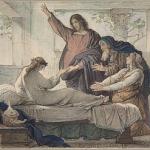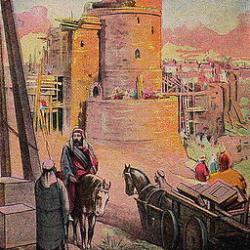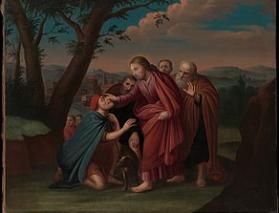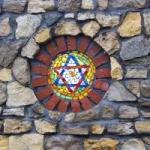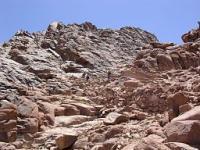
Prophets through the ages have taught God’s children to stand steadfast in holy places, refusing when tempted to move. Doing so gives them spiritual and physical safety in a turbulent world, enabling spiritual growth and progress in life. President Russell M. Nelson has taught that “we need to be in holy places because that is where we can best feel the Spirit of the Lord,” that spiritual survival is not possible “without the guiding, directing, comforting, and constant influence of the Holy Ghost”.1
Individuals may be blessed as they stand steadfast on mountain tops, in natural beauty spots, and in holy places in their own communities and homes.
Instructed by God
Throughout the scriptures we learn of individuals who were brought by God to holy places, including mountain tops, to stand steadfast for His spiritual guidance and direction.
When the time came for the brother of Jared to build, equip, and cross the ocean in a ship, the Lord had him come to a mountain top. As well as talking directly with the Lord, this prophet was able to see him. When Nephi needed ship instruction, the Lord summoned Him also to the mountains.
When the Lord prepared Moses for his earthly mission, He appeared to him in a burning bush which was holy ground, commanding him to remove his shoes. Later He summoned Moses to a mountain top to receive His commandments.
When Jesus knew it was time for Peter, James, and John to have a transcendent vision of Him with Moses and Elijah, who kept keys to powers they needed to receive, He took them to a holy mountain top where they would receive this vision, the keys, and the Father’s spoken testimony.
Inspired by Nature
Some who could not be summoned directly by God to sacred spaces were inspired to find their own. In 1807 William Wordsworth, who later became known as “the poet of nature,” lamented,
The world is too much with us; late and soon,
Getting and spending, we lay waste our powers;
Little we see in Nature that is ours . . .
For this, for everything, we are out of tune; 2
Wordsworth came into tune as he found his holy places in nature. Samuel Coleridge, a close friend who often wrote and published with him, was more specific as he addressed God,
So will I build my altar in the fields,
And the blue sky my fretted dome shall be,
And the sweet fragrance that the wild flower yields
Shall be the incense I will yield to Thee, 3
Since 1864, Christians worldwide have sung their gratitude for their holy places with “For the Beauty of the Earth” by Folliott S. Pierpoint.
For the beauty of each hour
Of the day and of the night,
Hill and vale and tree and flow’r,
Sun and moon, and stars of light,
Lord of all, to thee we raise
This our hymn of grateful praise. 4
Revealed in the Restoration
Those living since the restoration have been and are continually blessed with holy places to stand steadfast.
The restoration began in a holy place. Joseph Smith went to a what we now reverently call “the Sacred Grove” to offer the prayer that changed everything. His mother went there to pray, so for the Smith family this was already a sacred place.
In the prayer dedicating the Kirtland Temple, Joseph Smith recalled the Lord’s instructions from an earlier revelation to “prepare every needful thing, and establish a house . . . of prayer, a house of fasting, a house of faith, a house of learning, a house of glory, a house of order, a house of God” (D & C, 109:8).
We now have temples, the holiest of spaces, available worldwide, where we can worship and learn, as we receive ordinances and make covenants that bind us to our Heavenly Father and His beloved son, our Savior. And we must stand steadfast in our knowledge and commitments.
Despite the contention of the world today; if we stand steadfast in holy places we can receive solace and spiritual relief. In addition to temples, we can find holy places in chapels, in spaces devoted to church administration and service, and in beautiful surroundings of nature. President Nelson instructed that we can also make our homes “true sanctuaries of faith, where the Spirit can dwell.” 5
To stand steadfast in holy places is fundamental to the faith taught in the Church of Jesus Christ of Latter-day Saints. It is about putting God first in our lives. We must turn away from worldly chaos and evil and rivet our focus on Jesus Christ and all that is wholesome and good.
As the world increases its focus on materialism and worldly pursuits, we need more places of refuge to focus on what matters most. As President Nelson warned,
If we are not careful, we will miss the spiritual guidance we so desperately need. We live in a world that is complex and increasingly contentious. The constant noise of our adversary’s tools blurs out the Savior’s messages, making it ever more difficult to hear Him. 6
By recognizing and enhancing holy places in our homes and communities, as well as among the beauties of God’s creations, we can find solace and spiritual guidance in a challenging world. We can stand apart and separated from worldly pursuits and evils, as we seek things that are “virtuous, lovely, or of good report or praiseworthy.” 7
As we search the scriptures, contemplate glories of nature, and study the blessings of the restoration, we can strengthen our faith, and increase our ability to hear the still, small voice of the Holy Ghost, as we stand steadfast in our commitments to spend time in holy places with and become more like our Savior and Redeemer, Jesus Christ.



